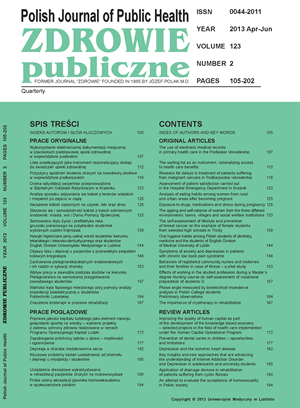The ageing and self-reliance of women from the three different environments: towns, villages and social welfare institutions
DOI:
https://doi.org/10.12923/j.0044-2011/123-2/a.07Keywords:
ageing , town, village, physical activity, self-relianceAbstract
Introduction. The process of ageing is inevitable. It has an individual nature and may intensify in various stages of adult life. A significant factor affecting the rate of the changes due to old age is the living environment.
Aim. The purpose of study is an attempt to get hold of the process of ageing changes in women. Growing old has been related with the concept of self-reliance in daily activities.
Materials and methods. Two hundred and eight women have been included in the examinations. The arithmetical average of the calendar age of the examined women is equ- al to =72.5 years, with median equal to Me=73 years. The women have inhabited three environments: villages, towns and social welfare institutions. The average number of chil- dren born by the examined women has amounted to three, but the village women gave more births. The residents of the social welfare institutions have given birth to the least num- ber of children (average 1.7 children). Although once they lived in a village or a town, then as the group from the social welfare institution the number of their children has been the smallest.
Results. The women from the three analysed environ- ments have a similar ageing degree index (ADI), which may confirm the trans-environmental and individual occurren- ce of the somatoscopic features (grey hair, wrinkles, spots on hands, the condition of finger nails). Almost all the wo- men from villages have declared that they had never smo- ked, less frequently visited physicians and have taken less medicines. The reason for this could have been previous cul- tural conditioning (smoking was not considered appropriate for the village women), failure to use the physician’s help, and worse financial status.
Conclusion. The results concerning self-reliance, in terms of being dependent from family/guardian are approximate- ly the same in the three analysed environments. As long as there are no pain and mobility is preserved, the seniors wish to be self-reliant.
References
1. Kurek S. Population ageing research from a geographical perspective – methodological approach. Bull geography (Socio-Economic Series). 2007;8:29-49.
2. Stainer L. Living alone in later life, a case study of geographical gerontology. East Midland Geographer. 1999;21:12-23.
3. Synak B. The Polish family: stability, change and conflict. J Aging Stud. 1990;4(4):333-44.
4. Alun EJ, Hallman BC. Over the hill and far away, distance as a barrier to the provision of assistance to elderly relatives. Soc Sci Med. 1998;46(6):631-9.
5. Borowiak E, Kostka T. Predictors of quality of life in older people living at home and in institutions. Aging Clin Exp Res. 2004;16(3):212-20.
6. Śniadek J, Zajadacz A. Senior citizens and their leisure activity: understanding leisure behavior of elderly people in Poland. Stud Physic Culture Tourism. 2010;17(2):193-204.
7. Zając-Gawlak I, Groffik D. The decline in body height as an element of involution changes in somatic structure of women and men over 50 years of age. Gerontol Pol. 2010;18(4):183-93.
8. Nicita-Mauro V, Lo Balbo C, Mento A, et al. Smoking, aging and the centenarians. Exp Gerontol 2008;43:95-101.
9. Łukomska A, Wachowska J. Seniors’ viewpoints on old age. Gerontol Pol. 2008;16(1):51-5.
10. Minois G. Histoire de la viellesse Del’ Antiquitéà la Renaissance Librairie Arthème Fayard; 1987.
11. Borowiak E, Kostka T. Demand for nursing care services in the elderly inhabitants of urban and rural areas and elderly patients in care and nursing facilities. Gerontol Pol. 2010;18(4):207-14.
12. Humańska MA, Kędziora-Kornatowska K. Influence of place of residence on nutrition in the elderly. Gerontol Pol. 2009;17(3):126-8.
13. Sulander T. The association of functional capacity with health-related behavior among urban home-dwelling older adults. Arch Gerontol Geriatr. 2011;52:e11-e14.
14. Wojszel B, Bień B. Stan zdrowia i sprawność populacji osób w zaawansowanej starości w środowisku dużego miasta i wsi. In: J. Charzewski (ed). Problemy starzenia. Czwarte warsztaty antropologiczne. Warszawa: AWF; 2001. p. 37-47.
15. Hank K, Buber I. Grandparents caring for their grandchildren. Findings from the 2004 survey of health, ageing, end retirement in Europe. J Fam Issues. 2009;30(1):53-73.


